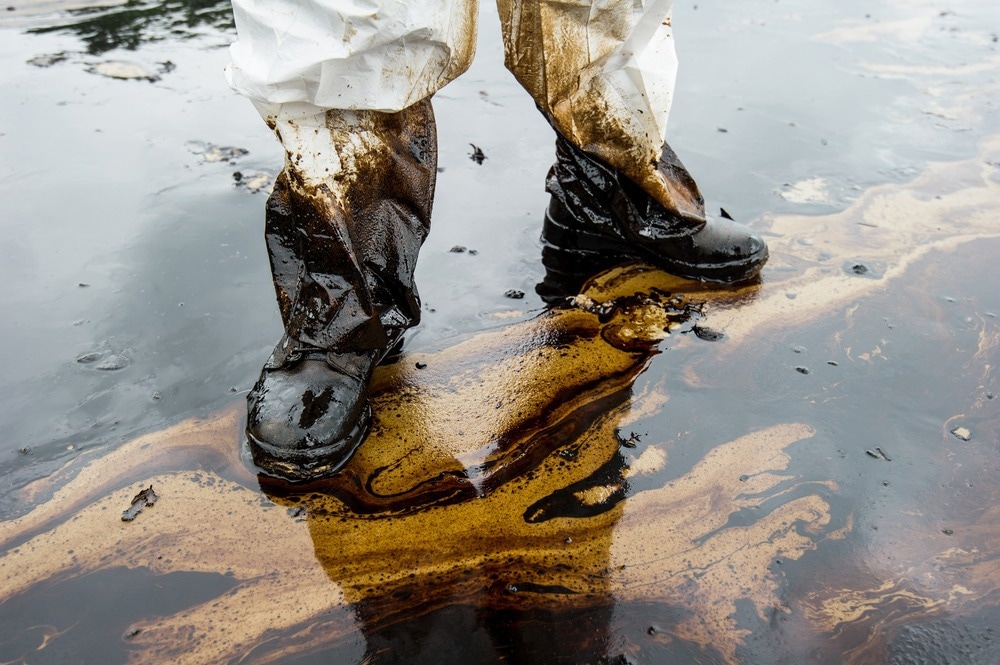In a paper recently published in the journal Ocean Engineering, researchers employed a free-surface vortex method for crude oil recovery, while studying its flow process in a vortex by carrying out scaled laboratory experiments.

Background
Oil contamination in oceans is a serious environmental concern. The likelihood of maritime oil spill incidents has grown due to the rising demand for energy. Severe oil spill incidents generate enormous economic losses, casualties, as well as environmental pollution in vast regions of the sea.
Oil spills can be recovered by biological, physical, and chemical methods. The drawbacks of biological and chemical methods include their limited application and high costs, respectively. Utilizing equipment like oil skimmers is a common physical technique for cleaning up oil spills. In the present study, a novel vortex skimmer was developed, indicating a greater processing capacity than conventional skimmers.
About the Study
In this study, analyses on cyclone separation and vortex recovery were carried out. A cyclone separator and an oil skimmer made up the two components of the experimental setup. Two liquid components were utilized, with tap water being the highest amount and crude oil from the Bohai Sea being used for the test oil spill.
The white oil that was tested was a less viscous, lighter lubricant. Rheological tests were carried out on the oil samples to determine the viscosity-temperature and density characteristics of the crude oil and diesel-mixed oil. The tangential velocity model was applied to analyze the change law and distribution of the velocity to understand the oil spill mechanism.
Furthermore, the free-surface vortex was numerically calculated. The momentum equation was solved using the Semi-Implicit-Method for Pressure Linked Equations (SIMPLE) method, and the discretization was conducted in the second-order upwind fashion. the continuity equation was solved by employing The Reynolds average equation's k- ε model by the Renormalization Group (RNG).
Observations
An isosurface was established at 50% oil content in the flow field to determine the crude oil's movement state. The free surface oil accumulation started at five seconds, having the shape of an inverted cone. The tangential velocity at the flow field bottom showed a definite rising trend, whereas the upper velocity reduced in comparison. A similar-sized vortex was also observed.
Furthermore, the surface of the liquid turned concave as the vortex grew, with a gas phase possibly present in the horizontal section's center. The results of the simulation were consistent with the three models' velocity distribution patterns. Across the radial position, the tangential velocity progressively reduced while the changing trend steadily slowed.
At seven seconds, the vortex coated with white oil had a somewhat greater tangential velocity than that covered with crude oil. Conversely, at 14 seconds, the vortex had been fully developed, with the velocity difference disappearing, suggesting that the vortex's final state was unconnected to the conditions during the initial oil spill.
Furthermore, white oil was usually recovered later than crude oil. The recovery capacity was dramatically reduced when the total treatment efficiency exceeded 80%. The recovery process commenced earlier when the crude oil was thicker and had a faster recovery rate when it was thinner. The overall total treatment efficiency was over 95% for both white oil and crude oil.
At identical inlet flows, higher internal pressures were observed at increased pump frequencies. Using white oil for the same experiment showed that the increase in flow rates decreased the pressure. Moreover, for the same flow and distance, crude oil exhibited a higher coefficient of friction, viscosity, and pressure loss compared to white oil. Crude oil recovery efficiency, on the other hand, was more susceptible to split ratio variations. The recovery efficiency increased along with the split ratio. The crude oil recovery efficiency and the split ratio did not, however, exhibit any previously predicted relationship.
Conclusions
To summarize, the researchers investigated the operation of an oil spill treatment system made up of an axial hydrocyclone separator and a free-surface vortex oil skimmer through experimental testing and Computational Fluid Dynamics (CFD) simulations. The study demonstrated that identical flow states may be simulated by featuring flow computational burdens using the RNG k-ε model and the volume of fluid (VOF) model to compute vortex motion.
This study confirmed the axial hydrocyclone's separation properties in the processing of crude oil. The rheological characteristics of the mixture had an impact on the flow within the separation device. Within this spectrum, boosting the split ratio can enhance the efficiency of separation. These results can also aid petroleum and sewage treatment industries in developing optimal equipment designs for treating liquid mixtures with differing densities.
More from AZoM: How Far Can Semiconductor Manufacturing Be Automated?
Disclaimer: The views expressed here are those of the author expressed in their private capacity and do not necessarily represent the views of AZoM.com Limited T/A AZoNetwork the owner and operator of this website. This disclaimer forms part of the Terms and conditions of use of this website.
Source:
Yang, M., Hou, L., Wang, L., Liu, S., Xu, J., Effect of oil properties on spilled oil recovery using a mechanism coupling surface vortices and cyclone separation, Ocean Engineering, 2022, 112383, DOI: https://www.sciencedirect.com/science/article/pii/S0029801822016754?via%3Dihub